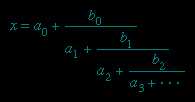continued fraction
mathematics
expression of a number as the sum of an integer and a quotient, the denominator of which is the sum of an integer and a quotient, and so on. In general,

where a0, a1, a2, … and b0, b1, b2, … are all integers.
In a simple continued fraction (SCF), all the bi are equal to 1 and all the ai are positive integers. An SCF is written, in the compact form, 【a0; a1, a2, a3, …】. If the number of terms ai is finite, the SCF is said to terminate, and it represents a rational number; for example, 802/251=【3; 5, 8, 6】. If the number of these terms is infinite, the SCF does not terminate, and it represents an irrational number; for example, √23=【4; 1, 3, 1, 8】, in which the bar spans a sequence of terms that repeats indefinitely. A nonterminating SCF in which a sequence of terms recurs represents an irrational number that is a root of a quadratic equation with rational coefficients. Nonterminating SCFs that represent numbers such as π or e can be evaluated after any given number of terms to obtain a rational approximation to the irrational quantity.
- Hirado
- Hiragushi Denchū
- Hirakata
- Hiram
- hiramaki-e
- Hiram Bingham
- Hiram Boardman Conibear
- Hiram College
- hirameji
- Hiram Johnson
- Hiram Percy Maxim
- Hiram Powers
- Hiram R Revels
- Hiram Sibley
- Hirata Atsutane
- Hiratsuka
- Hiri Motu
- Hirohito
- Hironaka Heisuke
- Hirosaki
- Hiroshige
- Hiroshima
- Hirpini
- Hirsch, E.D., Jr.
- Hirschfeld, Al